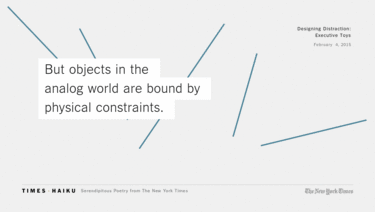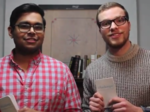By Charlie Molthrop and Labib Rahman, 2014 Venture for America Fellows
In April of 2013, the New York Times launched Times Haiku, an algorithm-driven Tumblr that scans "All the News That's Fit to Print" for sentences that conform to the grade-school definition of the haiku: five syllables, then seven, then five. It turns out that if a haiku is easy enough for a 1st grader to identify, it's not too hard for a computer either.
As Jacob Harris, the Times' senior software architect, readily admits on the blog's about page: "Not every haiku our computer finds is a good one," so the final haikus are hand-picked by Times staff. Even bound by the syntax of the Times' AP-style monotone, the haikus are imbued with a certain curious gravitas, like this one from an article about desk ornaments:

The accidental haikus of twitter are of a slightly different breed. Perhaps most obviously, they aren't taken out of context. Tweets are crafted to stand alone from the start. Unlike the haikus of the New York Times, Twitter's accidental haikus (and yes they're almost all inadvertent) are often the opposite of newsworthy -- made to be read once (or never) and soon forgotten. But it's the inconsequence of the tweet that can make it a better subject of the Internet's poetic curiosity. There's no filter between the author and their audience, and the ephemera of a tweet often encourages the transcription of a half-considered musing:
The Internet has a notoriously short attention span. @haikoops, the Twitter bot we created to recognize Twitter's accidental haikus, invites users to take one final look back at their last tweet before it fades off into the sunset (and the Library of Congress).
Coding is laborious. When you've spent hundreds of hours on a series of letters and numbers that reads other letters and numbers in order to find certain other letters and numbers, you can't help but try to explain to yourself why you're doing it. Maybe there's something about being able to tell someone they made something cool just by being themselves. Maybe there's a part of all of us that wants to celebrate mundanity rather than scorn it because that's what most of life is. Maybe there's an inherent beauty to our construction of language that brings balance and zen to the digital subconscious.
Maybe.
 Charlie Molthrop and Labib Rahman are 2014 Venture for America Fellows that currently live and work in Detroit at Next Energy and Mason, respectively. They've teamed up for the Venture for America Innovation Fund to create Haikoops, a Twitter bot that captures anytime someone accidentally tweets a Haiku, and with your help, a new book to share these tweet-poems with the world. Their unofficial book of Twitter's best accidental haikus can be funded here. They hope to split the profits with the poets who didn't know it.
Charlie Molthrop and Labib Rahman are 2014 Venture for America Fellows that currently live and work in Detroit at Next Energy and Mason, respectively. They've teamed up for the Venture for America Innovation Fund to create Haikoops, a Twitter bot that captures anytime someone accidentally tweets a Haiku, and with your help, a new book to share these tweet-poems with the world. Their unofficial book of Twitter's best accidental haikus can be funded here. They hope to split the profits with the poets who didn't know it.